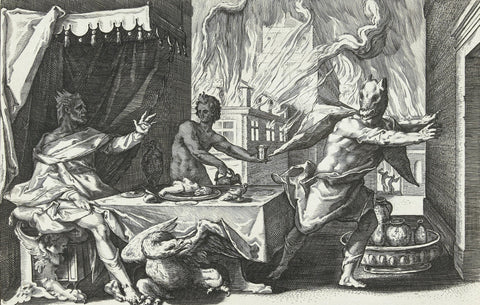Wolf-men, Werewolves, and Wild Places
by Owain Williams
At the dinner party of Trimalchio, Niceros, a freedman, who has so far remained quiet during the party, is called upon to tell a story to entertain the other dinner guests. The beginning of his tale seems to be a simple love story, although a comedy rather than a tragedy, with Niceros, while he was still a slave, falling in love with Melissa of Tarentum, the wife of an innkeeper, who was always kind to him.

One night, while his master was out of town, Niceros decided to visit Melissa. He persuaded a guest who was staying in his master’s house, a soldier, to accompany him for part of the journey. Suddenly, when they were passing through a cemetery, while the moon shone high above, the soldier began to undress. He dropped his clothes in a pile, sprinkled them with water, and then turned into a wolf! Howling, he ran off into the woods.
Niceros went to take the soldier’s clothes, but they had turned to stone. So, shaking in fear, Niceros continued to the house of his love. There, he learned that a wolf had attacked Melissa’s sheep, but a slave had managed to see it off by attacking it with a spear, striking it in the neck. Returning home, the next day, Niceros discovers the soldier abed, while a physician tends to a wound in his neck. He clearly had not imagined it - the soldier was a werewolf!
This story, from Petronius’ Satyricon (62), is but one many tales from the ancient world describing what modern readers might understand as a werewolf. Most tales of werewolves come from ancient Rome, particularly from the post-Republican period. However, that most references to werewolves in our sources come from Rome may simply be an accident of survivability. Indeed, it is possible that the myth of humans turning into wolves is of considerable antiquity.
The oldest reference to people turning into wolves as a matter of nature comes from Herodotus, who records a story of the Neuri, a Scythian tribe, who, for a few days every year, transform into wolves (4.105). Herodotus himself does not believe this tale, but according to his testimony, the Scythians and the Greeks living in Scythia do.

The most well-known example of werewolves in Greco-Roman myth, however, is the story of Lycaon, a mythical king of Arcadia. This tale first appears in Plato’s Republic (8.565d-e), although the information Plato reveals is limited, as he is using the myth to discuss tyranny. Plato’s reference to the myth only mentions the idea that those who consume human flesh are turned into wolves, associating the myth with the shrine of Lycaean Zeus in Arcadia, he does not mention any further details. Yet, Plato does seem to suggest that the myth was well-known, even if one of his characters claims to not know of it.
To learn about the details of this myth, we must, once again, look to Roman sources. Several different versions of the myth survive, while other authors record additional stories. According to Ovid, writing in the late-first century BC to the early-first century AD, Lycaon, wanting to test the divinity of Zeus, served him the meat of a hostage from the Molossians, and in answer of this sacrilege, Zeus destroyed Lycaon’s hall, burning it, and turned Lycaon into a wolf, so that his desire for slaughter was directed instead to sheep (Metamorphoses, 1.216-239).

Hyginus, a contemporary of Ovid, records a similar story in his Fabulae. However, it is not Lycaon that seeks to test Zeus’ divinity, but his son Arcas, although it is Lycaon who is transformed into a wolf, while his sons are killed (176). Pausanias, writing in the second century AD, records that Lycaon was turned into a wolf not because he fed Zeus the flesh of a human directly, but that he sacrificed a baby upon his altar (8.2.3). Pliny the Elder similarly attests to the practice of human sacrifice in Arcadia (Natural History 8.82), but the historicity of such claims is dubious. While these sources all seem to accept that Lycaon was turned into a wolf by Zeus, this was not universal. Pseudo-Apollodorus' Library records a version of the myth where, after trying to feed Zeus the meat of a human child, instead of being transformed into wolves, Lycaon and his fifty sons, save Nyctimus, were killed by Zeus’ thunderbolts (3.8.1).
It seems that the association of shape-changing into a wolf was not only associated with Lycaon, king of Arcadia, but with the Arcadians themselves. According to Pliny the Elder, a member of the clan of Anthus is chosen to leave the clan for nine years, and during this time he is said to transform into a wolf (Natural History 8.81). If he who is chosen can refrain from tasting human flesh in those nine years, he will transform back into a human. Pausanias even records the story of one such event, save that he does not mention the wider ritual, recording that it only happened to Damarchus of Parrhasia (6.8.2).

It should really come as no surprise that Arcadia is the setting of a myth that involves the crossing of the boundaries between the human world and the natural world, a concept prevalent in Ancient Greek thought. Indeed, now often used as a synonym for a rustic utopia, Arcadia has long been recognised as a wild place, particularly through its association with the god Pan (for example, Herodotus 6.105). Clearly, of all the mythological creatures conjured by humanity’s imagination, and while the details have somewhat changed over the years, werewolves are one of the most enduring.
Happy Halloween!


1 comment
This article stems from excellent research and analysis. I knew Brom Stoker was the originator of the Dracula legend, and Mary Shelley the originator of the Frankenstein legend, but always wondered about the origin of the werewolf until now. The wolf always played an important role in Roman mythology. Thank you.